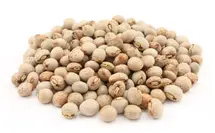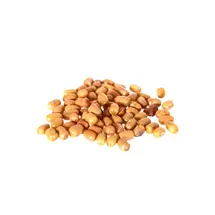top of page
GRAINS, CEREAL & PULSES

Red Kidney Bean
Red kidney beans, scientifically known as Phaseolus vulgaris, are a type of kidney-shaped bean that is typically red or dark red in color. These beans are a popular and nutritious legume used in a variety of culinary applications around the world. Red kidney beans are known for their distinctive appearance, large size, and robust, nutty flavor. They are a good source of plant-based protein, dietary fiber, vitamins, and minerals.

Black Gram
Black gram, scientifically known as Vigna mungo, is a type of pulse or legume widely cultivated in South Asia. It is a small, black-skinned bean with a white interior. Black gram is valued for its rich nutritional content, including protein, dietary fiber, vitamins, and minerals. It is a good source of essential nutrients such as iron, calcium, and magnesium.

Chickpea Bean
Chickpeas, scientifically known as Cicer arietinum, are a versatile and nutritious legume that has been cultivated and consumed for centuries in various parts of the world. Chickpeas are round, beige or light brown beans with a slightly nutty flavor. Chickpeas are highly nutritious and are a good source of plant-based protein, dietary fiber, vitamins (particularly B vitamins), and minerals such as iron, magnesium, and potassium. They are also rich in antioxidants, which can offer various health benefits.

Soybeans
Soybeans, scientifically known as Glycine max, are a type of legume native to East Asia. Soybeans are a rich source of plant-based protein, and they contain all essential amino acids, making them a valuable component of vegetarian and vegan diets. They are also high in dietary fiber and provide essential nutrients like iron, calcium, and magnesium. Soybeans are known for their potential health benefits, including heart health and the reduction of cholesterol levels.

Pigeon Peas
Pigeon peas, scientifically known as Cajanus Cajan, are a type of legume native to tropical and subtropical regions. Pigeon peas are typically small, round beans with a pale, beige or yellowish color and a slightly nutty flavor. They are a good source of plant-based protein, dietary fiber, vitamins (particularly B vitamins), and minerals such as iron, potassium, and magnesium.

Barley
Barley, scientifically known as Hordeum vulgare, is a versatile cereal grain that has been cultivated for thousands of years. Barley grains are small, oval-shaped, and come in a range of colors, including white, hulled (with the outermost layer removed), and the less common whole grain barley. Barley is a good source of dietary fiber, particularly beta-glucans, which are known to have cholesterol-lowering properties. It also contains vitamins and minerals, including B vitamins, iron, magnesium, and selenium.

Green Gram
Green gram, scientifically known as Vigna radiata, is a small, green legume that is widely cultivated and consumed in various parts of the world. It is known by several names, including mung bean and moong bean. It is also rich in dietary fiber, vitamins (such as vitamin C and some B vitamins), and essential minerals like iron and potassium.

Green Peas
Green peas, scientifically known as Pisum sativum, are a small, spherical legume. Green peas are a good source of essential nutrients, including dietary fiber, vitamins (such as vitamin C, vitamin K, and several B vitamins), and minerals like iron, magnesium, and potassium. They are also rich in antioxidants, such as carotenoids.

Black eyed Peas
Black-eyed peas, scientifically known as Vigna unguiculata. Black-eyed peas are characterized by their cream-colored skin with a small black spot or "eye" on one side, which gives them their name. These legumes are nutritious, providing a good source of plant-based protein, dietary fiber, vitamins (such as vitamin A and B vitamins), and minerals, including iron, potassium, and magnesium.

Bambara Bean
Bambara bean, scientifically known as Vigna subterranea. Bambara beans are small, round, and typically brown or beige in color. They are an excellent source of plant-based protein, dietary fiber, vitamins (including B vitamins), and essential minerals like iron, magnesium, and potassium. Bambara beans are also rich in antioxidants and phytonutrients.

Moth Beans
Moth beans, scientifically known as Vigna aconitifolia. Moth beans are characterized by their small, oval shape and brown or reddish-brown color. Moth beans are a nutritious food source, providing plant-based protein, dietary fiber, vitamins (such as B vitamins), and essential minerals like iron and potassium.

Maize
Maize, scientifically known as Zea mays. Maize is a good source of carbohydrates and dietary fiber. It contains essential nutrients such as vitamins (particularly B vitamins) and minerals like magnesium and phosphorus.

Oats
Oats, scientifically known as Avena sativa, are a nutritious whole grain cereal. They also provide vitamins (such as B vitamins), minerals like iron and magnesium, and antioxidants.

Millet
Millet is a group of small-seeded, cereal grains that have been cultivated for thousands of years. Millet grains are small, round, and can vary in color depending on the variety, with shades of yellow, white, gray, or red. These grains are gluten-free and rich in essential nutrients such as dietary fiber, vitamins (including B vitamins), and minerals like magnesium, phosphorus, and iron.

Red Lentil
Red lentils, scientifically known as Lens culinaris, are a type of small, round legume that are highly nutritious, offering a good source of plant-based protein, dietary fiber, vitamins (particularly B vitamins), and minerals like iron and magnesium.
Reach Us
Thank you for visiting our website! We value your feedback, questions, and suggestions. If you need to get in touch with us, here are the ways you can reach us:
Contact Information:
Level 2, Paramount Tower, 192/10, 9th Lane,
Nawala Road, Nawala, Sri Lanka
Follow Us
Stay connected with us and be a part of our online community! Follow us on social media to get the latest updates, news, and exclusive content.
Connect with Us:
Opening Hours
Mon - Fri
8:30 am – 5:30 pm
Saturday
8:30 am – 1:00 pm
Sunday
Closed
Quick Links
Useful Links
bottom of page